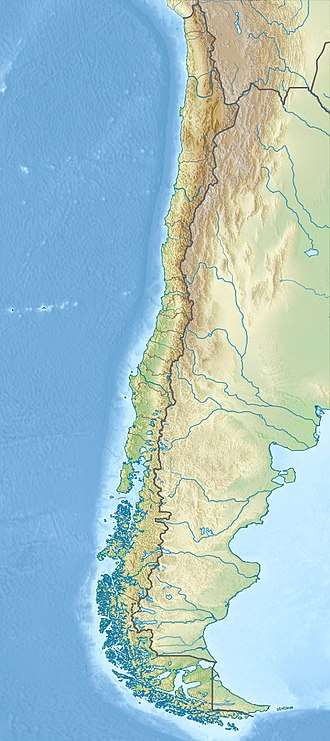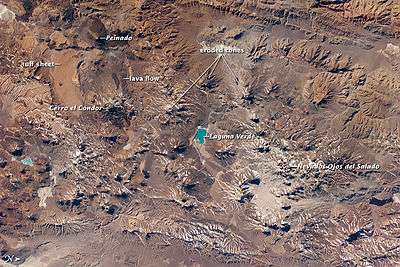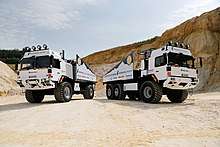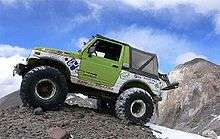Ojos del Salado
Nevado Ojos del Salado is an active stratovolcano in the Andes on the Argentina–Chile border and the highest active volcano in the world at 6,893 m (22,615 ft).[3] It is also the second highest mountain in both the Western Hemisphere and the Southern Hemisphere behind Aconcagua at approximately 7,000 meters (22,966 ft) and it is the highest in Chile. Nevado Ojos del Salado is translated to Snowy Salty Eyes describing it being very snowy in the winter and salty with many lakes.
| Ojos del Salado | |
|---|---|
 The volcano looming on the horizon. | |
| Highest point | |
| Elevation | 6,893 m (22,615 ft) [1] |
| Prominence | 3,688 m (12,100 ft) [1] Ranked 44th |
| Isolation | 631 km (392 mi) |
| Listing | Volcanic Seven Summits Seven Second Summits Country high point Ultra |
| Coordinates | 27°06′35″S 68°32′29″W |
| Geography | |
 Ojos del Salado Location on the Argentina–Chile border | |
| Location | Argentina–Chile |
| Parent range | Andes |
| Topo map | Highest mountain: Highest Mountain in Chile |
| Geology | |
| Mountain type | stratovolcano |
| Last eruption | 700 AD ± 300 years[2] |
| Climbing | |
| First ascent | February 26, 1937 by Jan Alfred Szczepański and Justyn Wojsznis |
| Easiest route | Scramble |

Due to its location near the Atacama Desert, the mountain has very dry conditions, with snow usually only remaining on the peak during winter, though heavy storms can cover the surrounding area with a few feet of snow even in summer. Despite the generally dry conditions, there is a permanent crater lake about 100 m (330 ft) in diameter at an elevation of 6,390 m (20,960 ft) on the eastern side of the mountain.[4] This is most likely the highest lake of any kind in the world.
The ascent of Ojos del Salado is mostly a hike except for the final section to the summit which is a difficult scramble that may require ropes. The first ascent was made in 1937 by Jan Alfred Szczepański and Justyn Wojsznis, members of a Polish expedition in the Andes.
Its name, meaning roughly "Eyes of the Salty One" in Spanish, comes from the enormous deposits of salt that, in the form of lagoons or “eyes”, appear in its glaciers.[5] An international highway between Chile and Argentina runs north of the mountain.[6]
Geology and geomorphology
Regional
Ojos del Salado along with several other high volcanoes such as El Muerto, El Solo, Nevado Incahuasi and Nevado Tres Cruces lies at the southern end of the Central Volcanic Zone of the Andes.[7]
Volcanic activity in the region commenced 26 million years ago in the Cordillera Claudio Gay, at the same time as the neighbouring Maricunga Belt volcanoes were active. Starting 18 million years ago, local subduction of the Nazca Plate beneath the South America Plate became increasingly shallower and this caused volcanism to shift from the Maricunga Belt to the Ojos del Salado region.[7]
The Paleozoic basement crops out only northwest of Nevado Tres Cruces. Other geologic units in the region are Oligocene sedimentary units and volcanic rocks ranging from Oligocene age to less than 1.5 million years old.[8] The area is part of a tectonic boundary between a volcanically active region north of the boundary and a less volcanically active region south of the boundary, which is also characterized by geographical differences, e.g. the presence of transverse valleys.[9]
Local
Ojos del Salado like other major neighbouring mountains is a complex of lava domes and lava flows, with the main summit surrounded by peripheral domes such as El Solo and El Fraile[10] and many other lateral centres.[11] Fumaroles are encountered at the summit of Ojos del Salado within a depression.[12] Potassium-argon dating has yielded ages of 1.2 ± 0.3 million years ago and less than 1 million years ago from rocks north of Ojos del Salado.[13]
There are glaciers on the mountain, in the crater and in the form of penitentes[14] which reach heights of 8–5 metres (26–16 ft).[15] Other reports indicate the absence of glaciers on Ojos del Salado. Permafrost exists on the mountain and its melting nourishes several lakes; one lake fed by a creek lies at 6,500 metres (21,300 ft) altitude.[16]
Ojos del Salado is an active volcano, but the question of whether it should be considered currently (or "historically") active is arguable. According to the Smithsonian Institution's Global Volcanism Program,[2] the most recent known eruption was about 1,300 years ago, with a large margin of uncertainty. However, there is also some evidence for a minor ash emission in 1993, which would definitely qualify the volcano as historically active. The presence of fumaroles high on the mountain and recent-looking lava flows, albeit of uncertain age, also argues in favor of a categorization as "active." By these definitions, Ojos del Salado is the highest historically active volcano on Earth. If the older date is accepted, the title of "highest historically active volcano" might reside instead with the somewhat lower Llullaillaco volcano, which certainly has erupted in historic times (most recently in 1877) and is considered active.
Composition
Salado's rock is predominantly potassium-rich dacite and rhyodacite. Its lavas are high in biotite, hornblende, plagioclase, and opaques, with lower levels of augite, quartz, and hypersthene.[17]
Elevation
The elevation of Ojos del Salado has been the subject of debate. The mountain is hidden behind other peaks and thus its height was not appreciated in early research until 1937, when the mountain was climbed by Polish climbers.[18]
A 2006 article in Andes Magazine offered that Ojos del Salado may be higher than Aconcagua, although the argument was premised on older, less accurate altitude surveys. The results of these older surveys assigned Ojos del Salado an elevation of 7,057 m (23,153 ft), which would have made it nearly 100 m (330 ft) higher than Aconcagua. As early as 1955, an estimate was made that the elevation of Ojos del Salado was 7,100 m (23,300 ft), but that was "simply [...] based on the altitude of the final camp, and the hours of ascent to the summit."[19] In 1956, the first Chilean expedition led by the retired lieutenant René Gajardo measured the height of Ojos del Salado as 7,084 m (23,241 ft) with a pocket pressure altimeter. Apart from being an inexact method, the height shown by the altimeter was far too high as air pressure is generally lower in the afternoon, the time at which the team reached the summit.[20]
An expedition to the area in the 1990s claimed that nearby Monte Pissis was even higher than Ojos del Salado. Later measurements using more precise equipment showed that Ojos del Salado is about 100 m (330 ft) higher than Pissis. Furthermore, in 2007 a Chilean–Argentine–European expedition organized by Andes Magazine and Azimut 360 performed a survey on both Ojos del Salado and Monte Pissis using more accurate instruments. It found the former to be 6,891 m (22,608 ft) and the latter 6,793 m (22,287 ft)[21] Although this fits within recent handheld GPS surveys, which have estimated the mountain to be between 6,880 m (22,570 ft) and 6,910 m (22,670 ft), the vertical error margin of the expedition's equipment, 10 m (33 ft),[21] leaves uncertainty as to the mountain's more precise altitude.
A DGPS study from Phillipe Reuter in 2007, measured Ojos del Salado as 6,891.7 meters (SIRGAS).[22]
Ojos del Salado has two summits, one in Argentina and the other in Chile (the border between the two countries runs between the two summits). The difference in elevation of the two summits is less than 1 m (3 ft 3 in)
Motorized partial ascent

Ojos del Salado has been a popular mountain for attempts to attain the highest altitude aboard a land vehicle.

The previous long-standing record altitude for a four-wheeled vehicle was set on April 21, 2007 by the Chilean duo of Gonzalo Bravo G. and Eduardo Canales Moya. Reaching an altitude of 6,688 meters (21,942 ft.) with a modified Suzuki Samurai, the duo beat the previous record of 6,646 m which had been set on March 13, 2007 by German Matthias Jeschke in a Jeep Wrangler Unlimited Rubicon.[23]
Jeschke set the high altitude record for trucks reaching a height of 6,675 meters (21,899 ft) with a Mercedes-Benz Zetros truck on March 6, 2015. This is also a world record for a diesel-powered engine.[24]
On April 19, 2015 Chilean Gianfranco Bianchi reached an altitude of 6,472 m (21,233 ft) with a Suzuki RMZ 450, setting the altitude record for a motorcycle.
On November 6, 2017, Matthias Jeschke, again, attempted to gain two world records, one for construction at altitude and the other by beating the then current 6,688 m record.[25] A refuge hut was built at 6,100 m (a record), but on December 19 it was announced the altitude record attempt had been called off at a height of 6,150 m for a combination of factors including an insurmountable rock barrier and adverse weather conditions.[26]
On December 13, 2019, a 10-person team led once again by Matthias Jeschke finally succeeded in breaking long-standing record. They reached an altitude of 6,694 m (21,962 ft) in a modified Mercedes-Benz Unimog U 5023. It was part of an expedition to set up an emergency radio system on top of the volcano. [27]
See also
References
- "Andes ultra-prominent peaks". Peaklist.
- "Ojos del Salado". Global Volcanism Program. Smithsonian Institution.
- Borsdorf, Axel; Stadel, Christoph (March 12, 2015). The Andes: A Geographical Portrait. Springer Science+Business Media. p. 7. ISBN 978-3-319-03530-7.
- "Andes Website – Information about Ojos del Salado volcano, a high mountain in South America and the World's highest volcano".
- "Los 6000 de Chile". Banco de Chile. Archived from the original on July 13, 2007.
- Carter 1957, p.242
- Mpodozis, C and Kay, Suzanne and Gardeweg, M and Coira, B, 1996, p.539
- Mpodozis, C and Kay, Suzanne and Gardeweg, M and Coira, B, 1996, p.541
- P. E. BAKER, O. GONZALEZ-FERRAN and D. C. REX, 1987 p.85
- Mpodozis, C and Kay, Suzanne and Gardeweg, M and Coira, B, 1996, p.545
- Mpodozis, C and Kay, Suzanne and Gardeweg, M and Coira, B, 1996, p.546
- P. E. BAKER, O. GONZALEZ-FERRAN and D. C. REX, 1987 p.90
- Mpodozis, C and Kay, Suzanne and Gardeweg, M and Coira, B, 1996, p.542
- "Inventario de glaciares de los Andes chilenos desde los 18º a los 32º de latitud sur". Revista Geografía Norte Grande (in Spanish). March 8, 2014. Archived from the original on March 7, 2018. Retrieved March 6, 2018.
- Lliboitry, Louis (1954). "The Origin of Penitents". Journal of Glaciology. 2 (15): 334. doi:10.3189/S0022143000025181. ISSN 0022-1430.
- Aszalós, Júlia Margit; Krett, Gergely; Anda, Dóra; Márialigeti, Károly; Nagy, Balázs; Borsodi, Andrea K. (September 1, 2016). "Diversity of extremophilic bacteria in the sediment of high-altitude lakes located in the mountain desert of Ojos del Salado volcano, Dry-Andes". Extremophiles. 20 (5): 603–620. doi:10.1007/s00792-016-0849-3. ISSN 1431-0651. PMID 27315168.
- "Nevados Ojos del Salado". Volcano World. Oregon State University. 2011. Retrieved July 29, 2011.
- Carter 1957, pp.240-241
- American Alpine Journal, 1956, p. 134; quoting the "Boletin Informativo No. 16" (June 1955) of the Argentine Associación Tucumana de Andismo.
- Lliboutry 1956.
- "A la Búsqueda del Techo de América" (in Spanish).
Phillipe Reuter: "El Ojos del Salado es 100 metros más alto que el Pissis"
- "Phillipe Reuter: "El Ojos del Salado es 100 metros más alto que el Pissis"". Retrieved April 7, 2020.
- "Matthias Jeschke Set New High Altitude World Record Aboard". Editorials. streetdirectory.com. Retrieved November 9, 2017.
- "Truck World Record". Extreme Events. Retrieved November 9, 2017.
- Rheinmetall MAN High Altitude Truck Expedition
- "Off-road expedition makes the world's tallest active volcano safer for climbers; attempt to set new world record temporarily thwarted". Rheinmetall. Retrieved December 19, 2017.
- "Sensation: Höhen-Weltrekord mit Unimog in Chile auf 6.694 m geknackt". Retrieved June 26, 2020.
Sources
- Baker, P. E.; Gonzalez-Ferran, O.; Rex, D. C. (February 1, 1987). "Geology and geochemistry of the Ojos del Salado volcanic region, Chile". Journal of the Geological Society. 144 (1): 85–96. doi:10.1144/gsjgs.144.1.0085. ISSN 0016-7649.
- Carter, Adams (1957). "The American Alpine Club Expedition to the Ojos del Salado". Geographical Review. 47 (2): 240–250. doi:10.2307/211595. JSTOR 211595.
- Mpodozis, C and Kay, Suzanne and Gardeweg, M and Coira, B (1996). "Geología de la región de Ojos del Salado (Andes centrales, 27°S): Implicancias de la migración hacia el este del frente volcánico Cenozoico Superior". 13° Congreso Geológico Argentino (in Spanish). pp. 539–548 – via ResearchGate.CS1 maint: multiple names: authors list (link)
Bibliography
- Darack, Ed (2001). Wild Winds: Adventures in the Highest Andes. Cordee / DPP. ISBN 978-1884980817.
- Gonzales-Ferran, Oscar (1995). Volcanes de Chile (in Spanish). Santiago, Chile: Instituto Geográfico Militar. p. 640. ISBN 978-956-202-054-1. (Also includes volcanoes of Argentina, Bolivia, and Peru)
- De Silva, Shanaka L.; Francis, Peter (1991). Volcanoes of the Central Andes. Springer-Verlag. p. 216. ISBN 978-3-540-53706-9.
- Biggar, John (2005). The Andes: A Guide for Climbers (3 ed.). Scotland: Andes Publishing. p. 304. ISBN 978-0-9536087-2-0.
- Lliboutry, Luis (1956). Nieves y Glaciares de Chile: Fundamentos de glaciología (in Spanish).CS1 maint: ref=harv (link)
External links
| Wikimedia Commons has media related to Ojos del Salado. |